BOAT FISHING
BACK TO TABLE OF CONTENTS
BOAT FISHING INDEX
FISHING OFF THE RUDDER
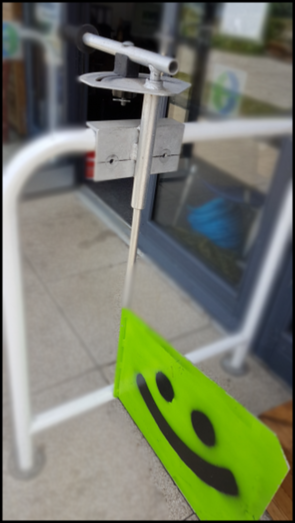 One step removed from loch style fishing is rudder fishing. Many venues prohibit the use of a rudder, so this is another occasion when you must seek the venue's advice before setting out. The idea of a rudder, which is clamped to the back of the boat, is to alter the line of drift. Imagine you have a nice straight littoral zone that you would like to drift down and fish new water with each cast. Great idea. But usually the wind will scupper this plan by blowing in an unhelpful direction. The rudder can overcome this handicap by steering the boat into the right direction. Once the rudder is set it shouldn't need too much attention, so you can get on with the important job of catching those fish.
One step removed from loch style fishing is rudder fishing. Many venues prohibit the use of a rudder, so this is another occasion when you must seek the venue's advice before setting out. The idea of a rudder, which is clamped to the back of the boat, is to alter the line of drift. Imagine you have a nice straight littoral zone that you would like to drift down and fish new water with each cast. Great idea. But usually the wind will scupper this plan by blowing in an unhelpful direction. The rudder can overcome this handicap by steering the boat into the right direction. Once the rudder is set it shouldn't need too much attention, so you can get on with the important job of catching those fish.
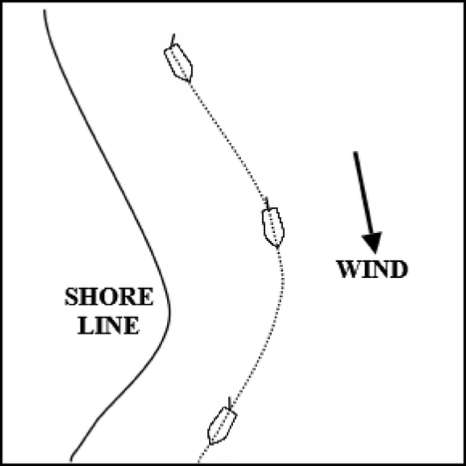 The whole point of rudder fishing is to ensure the boat follows a course that puts you where the fish are - and that usually means following a shore line at the depth of the littoral zone - ten to twelve feet. The illustration shows how the angle of the rudder can affect the direction of the boat. Note the angle of the rudder as the boat moves around the shoreline. At the first position the wind is pushing the boat towards the shore, so the rudder is moved to steer the boat away from the shore. As the boat moves around the headland the opposite side of the boat is affected by the wind pushing it away from the shore, so the rudder is moved to steer the boat towards the shore.
The whole point of rudder fishing is to ensure the boat follows a course that puts you where the fish are - and that usually means following a shore line at the depth of the littoral zone - ten to twelve feet. The illustration shows how the angle of the rudder can affect the direction of the boat. Note the angle of the rudder as the boat moves around the shoreline. At the first position the wind is pushing the boat towards the shore, so the rudder is moved to steer the boat away from the shore. As the boat moves around the headland the opposite side of the boat is affected by the wind pushing it away from the shore, so the rudder is moved to steer the boat towards the shore.
On some Scottish lochs and Irish loughs a g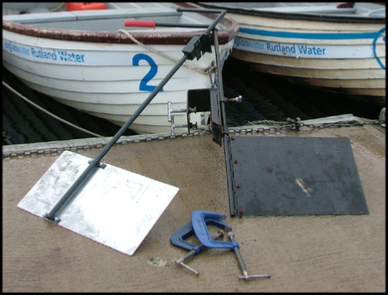 hillie is employed to advise and guide. He can also use the oars to row the boat along this ideal fishing line, negating the need for a rudder. He will know where these magical littoral zones are and how best to attack them. He will be able to approach them from the best direction, having taken the wind into account and give you the best casting angle. But you need a good ghillie, whose fees are measured in drams of whisky as well as currency! Alternatively, a rudder is the answer!
hillie is employed to advise and guide. He can also use the oars to row the boat along this ideal fishing line, negating the need for a rudder. He will know where these magical littoral zones are and how best to attack them. He will be able to approach them from the best direction, having taken the wind into account and give you the best casting angle. But you need a good ghillie, whose fees are measured in drams of whisky as well as currency! Alternatively, a rudder is the answer!
T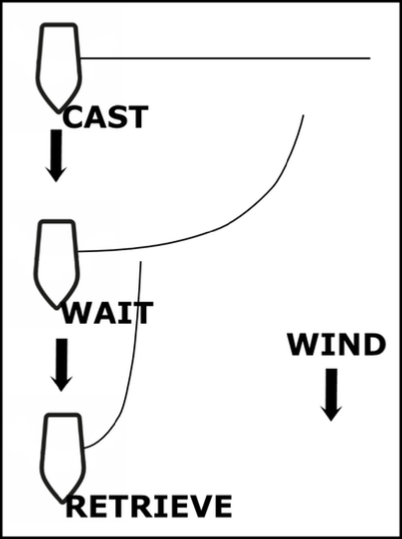 here are a variety of ways in which you can use your newly acquired rudder to expand your fishing adventures. One method which can produce huge takes is the swing fishing system. Having set your rudder to travel along your preferred route, cast your line straight out the side of the boat - amidships. You then wait while the wind moves you forward and your line sinks and is left behind. A slow or medium sink line should be used in this system and there should be no slack in the line. As the line swings round to follow the boat you should wait until the line is nearly parallel to the boat and then start retrieving. Takes can come at any time but you should note where in the process the action occurs. If the take is early in the procedure then it may indicate that the fish are sitting high in the water and it may pay to switch to a slower sink line - and vice versa if the takes are late in the process.
here are a variety of ways in which you can use your newly acquired rudder to expand your fishing adventures. One method which can produce huge takes is the swing fishing system. Having set your rudder to travel along your preferred route, cast your line straight out the side of the boat - amidships. You then wait while the wind moves you forward and your line sinks and is left behind. A slow or medium sink line should be used in this system and there should be no slack in the line. As the line swings round to follow the boat you should wait until the line is nearly parallel to the boat and then start retrieving. Takes can come at any time but you should note where in the process the action occurs. If the take is early in the procedure then it may indicate that the fish are sitting high in the water and it may pay to switch to a slower sink line - and vice versa if the takes are late in the process.
This is a relaxing way t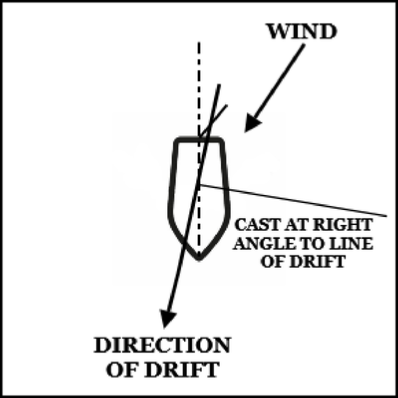 o fish as you are not continually casting and retrieving, but allowing the line to sink while the boat moves forward. Obviously, this system will only work if there is enough wind to get the boat moving at a reasonable speed. A further development on this idea of swing fishing is to steer the boat at a slight angle to the wind, towards the fishing side. This will present more of that side to the wind and cause the boat to move away from the fly line This keeps your line under pressure as it is pulled away from the boat and ensures there is no slackness in the line.
o fish as you are not continually casting and retrieving, but allowing the line to sink while the boat moves forward. Obviously, this system will only work if there is enough wind to get the boat moving at a reasonable speed. A further development on this idea of swing fishing is to steer the boat at a slight angle to the wind, towards the fishing side. This will present more of that side to the wind and cause the boat to move away from the fly line This keeps your line under pressure as it is pulled away from the boat and ensures there is no slackness in the line.
PITCH AND PAY
There are times when the fish sit deep and it becomes a challenge to get your flies down to them. This can be especially true for predatory browns as well as large rainbows. These fish are known to attack fry, not from the back, but from the side as they scatter. It seems to be the change of direction tha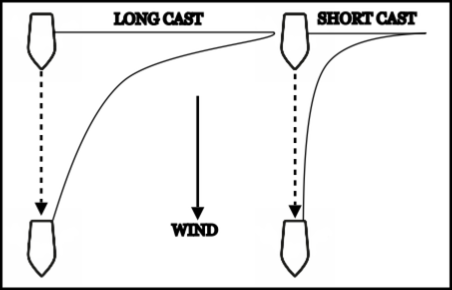 t induces the strike. How to use that to our advantage?
t induces the strike. How to use that to our advantage?
The answer is called Pitch and Pay. First use a fast sink line with a known sink rate with a fry imitation fly - baby doll, minkie, etc. I use a 6 i.p.s. hi-d line but different sink rates should be tried as well. Cast out from the side of the moving boat and immediately shake out backing and let it sink with the line. Count your line down in the water as it takes up the slack and gets left behind, allowing more backing if necessary. After the time allotted - 40 seconds for 20 feet for example - start your retrieve with long pulls. The line will be retrieved in an arc as it moves back up in the water and it is this change of direction that can induce the bigger fish to take.
It can be better to make shorter casts as this will make the change of direction on the retrieve more acute, as in the illustration. Explore different depths until you get a strike and then concentrate on that depth - most fish sit at similar depths. What’s good for one is generally good for more of them! This method has infinite variations of depth, retrieve rate, line sink rate etc. which can all be tried until a winning formula is found. Additionally, try casting at different angles – the further upwind you cast, the longer time the line will have to fall through the water.
SIDE SWIPING
There are days when you can see the fish moving on the surface – but they just won’t take a fly! And there doesn’t seem to be a hatch coming off anyway. So what on earth are they playing at – it can be really infuriating! Sometimes the fly are so tiny that you can hardly see them or on a gloomy day even in summer the daphnia may be at the surface and the fish are sipping these in. They become so pre-occupied that they will ignore anything else. A different strategy is required.
This method is all about sight fishing but, instead of trying to present a fly delicately on the fish’s nose, try casting a fry imitation just ahead of the fish and strip it back just as fast as you can! This is a shock tactic which is designed to awaken the chasing instinct in the fish. This method works best on calmer days when there is just enough wind to keep the boat moving forward. The fish will probably hear the splash of your fly hitting the water and may investigate. Takes will happen almost immediately – certainly within the first couple of pulls. Having said that, the odd fish will follow the fly right up to the boat, so make sure you hang it for a moment before lifting off. The fish may take that last opportunity to grab it.
With two people in the boat you need to address how both are going to cast without getting in each other’s way. In loch styling it is normal to fish from the side of the boat with the drogue fixed amidships. This means that – with two right handers in the boat – one is having to cast over the head of the other. This is fine with accomplished casters, but even they manage to get a cast wrong occasionally and the fly ends up in the other persons jacket – or worse! There is a solution to this problem that requires just a little re-organisation. You can either fish out of the stern of the boat or – my favourite solution – out of the front.
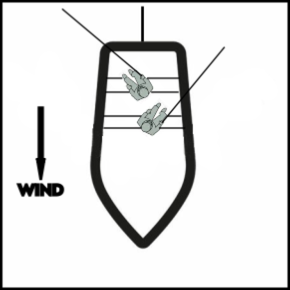 You can see from this diagram that sitting aft means that neither person is forced to cast over the top of the other. But it does mean that you are casting into the wind – which can reduce effective casting even on a relatively calm day. I think it’s much better to have both people sitting towards the front of the boat and fishing towards unspoilt water where it is more likely you will see a rising fish rather than the water you have just moved through and has been disturbed. Note that the rudder is amidships – this is essential to keep the boat moving straight forwards – otherwise the system is not effective as one or other will end up casting across the other anyway.
You can see from this diagram that sitting aft means that neither person is forced to cast over the top of the other. But it does mean that you are casting into the wind – which can reduce effective casting even on a relatively calm day. I think it’s much better to have both people sitting towards the front of the boat and fishing towards unspoilt water where it is more likely you will see a rising fish rather than the water you have just moved through and has been disturbed. Note that the rudder is amidships – this is essential to keep the boat moving straight forwards – otherwise the system is not effective as one or other will end up casting across the other anyway.
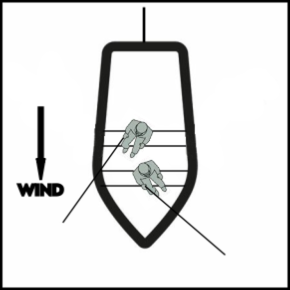 Here’s how it looks sitting in my preferred positions in the bow of the boat. Again, no-one is forced to cast over the top of the other person and each person concentrates on their side of the boat. Now the wind is behind you as you cast, giving an added advantage. Again it is essential that the rudder is amidships to keep the boat running true to the wind. This method should be used with a slow sink line – we are attacking fish we can see, so we want to keep our fly up in the water. But as we are stripping it back a floating line may be just too buoyant. Some prefer to use a sink tip line, thus ensuring only the first few feet are submerged.
Here’s how it looks sitting in my preferred positions in the bow of the boat. Again, no-one is forced to cast over the top of the other person and each person concentrates on their side of the boat. Now the wind is behind you as you cast, giving an added advantage. Again it is essential that the rudder is amidships to keep the boat running true to the wind. This method should be used with a slow sink line – we are attacking fish we can see, so we want to keep our fly up in the water. But as we are stripping it back a floating line may be just too buoyant. Some prefer to use a sink tip line, thus ensuring only the first few feet are submerged.
BACK TO TOP
BOAT FISHING INDEX
TABLE OF CONTENTS
